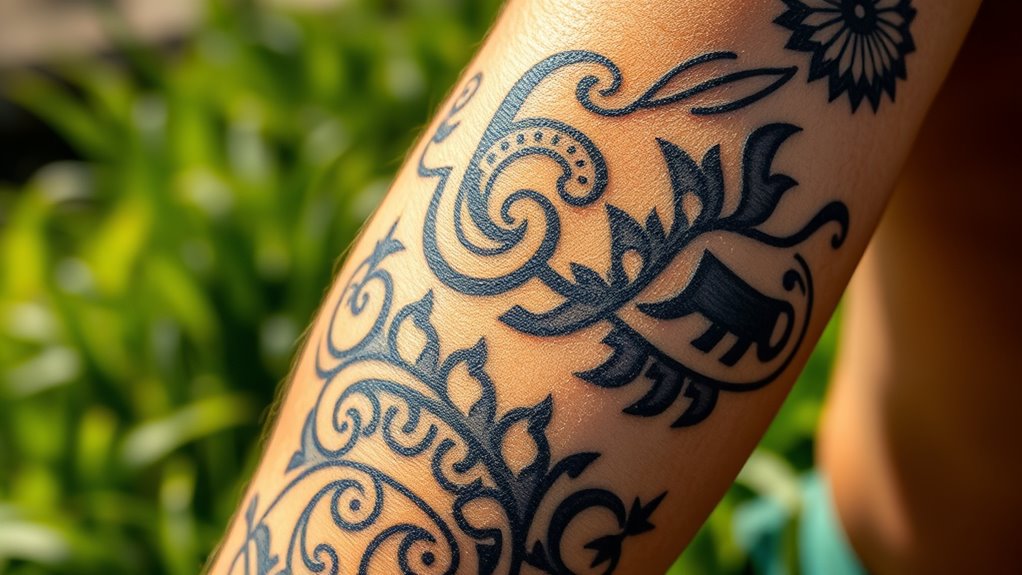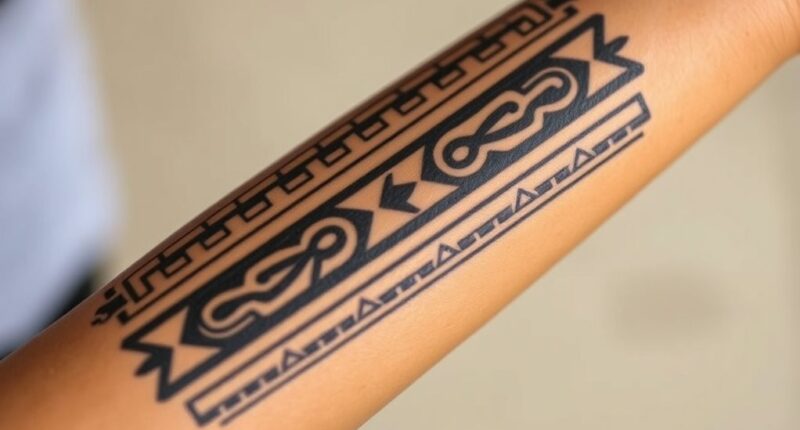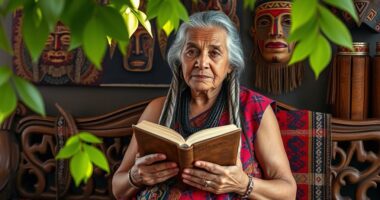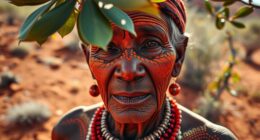Indigenous tattoo traditions use symbols and patterns that connect you to your ancestors, land, and spiritual beliefs. These designs often represent social status, achievements, or rites of passage, serving as visual stories of cultural identity. The tattooing process is sacred, involving ceremonies performed by elders who pass down techniques and meanings. Preserving these traditions keeps your community’s history and resilience alive. Keep exploring to discover more about these powerful cultural symbols.
Key Takeaways
- Indigenous tattoos often feature intricate geometric patterns and symbols representing kinship, spiritual guidance, and social status.
- Symbols in tattoos reflect connections to nature, animals, sacred stories, and community values.
- The tattooing process is a sacred ritual involving elders, preserving cultural techniques and spiritual significance.
- Preservation efforts focus on passing down traditional designs and methods to maintain cultural identity.
- Tattoos serve as living symbols of resilience, history, and spiritual connection within indigenous communities.

Indigenous tattoo traditions are a pivotal part of cultural identity and spiritual expression for many communities worldwide. These tattoos aren’t just decorative; they carry deep cultural significance that connects individuals to their ancestors, land, and spiritual beliefs. When you explore these traditions, you realize that each symbol, pattern, and placement holds specific meaning, often reflecting a person’s social status, achievements, or rites of passage. Preserving these tattoos is more than safeguarding art; it’s about maintaining a essential link to history and identity that can be easily lost amid modern influences. Efforts to keep these traditions alive involve respecting their origins, understanding their significance, and passing down techniques and meanings to future generations. By doing so, communities reinforce their cultural practices and guarantee that these traditions aren’t erased or diluted over time.
In many indigenous cultures, tattoos serve as visual language, communicating stories and values that words may fail to express. For example, some Polynesian tribes use intricate geometric patterns to symbolize kinship, bravery, or spiritual guidance. Similarly, Native American tribes often incorporate symbols representing nature, animals, or sacred stories that define their worldview. When you learn about these symbols, you begin to see how tattoos act as living history, embodying collective memory and cultural resilience. The act of tattooing itself is often a sacred ritual, requiring specific ceremonies and the involvement of community elders who hold the knowledge of traditional designs and techniques. Respecting this process is essential for tattoo preservation, as it guarantees that the cultural meaning remains intact and that the tattoos retain their spiritual power. Moreover, understanding the cultural significance of these tattoos helps ensure that the traditions are respected and accurately preserved.
Furthermore, the importance of tattoo preservation extends beyond individual identity; it’s about safeguarding a community’s legacy. As globalization and modern aesthetics influence younger generations, there’s a risk of losing these culturally significant practices. Many communities actively work to revive traditional tattooing methods, training new artists and educating outsiders about their significance. By doing so, they reaffirm their cultural importance and resist the homogenization of identity. When you support these efforts, you’re helping to guarantee that indigenous tattoo traditions continue to thrive as meaningful symbols of resilience, history, and spiritual connection. Ultimately, these tattoos are more than art—they are sacred markers of cultural survival, and their preservation guarantees that future generations can continue to honor their ancestors and cultural roots.
Frequently Asked Questions
How Do Indigenous Tattoo Techniques Differ Across Cultures?
You’ll notice that indigenous tattoo techniques differ across cultures through unique tools, methods, and styles. Some cultures use traditional hand-tapping or scraping, while others employ modern tattooing devices. These techniques serve as powerful forms of cultural expression and often hold ritual significance, symbolizing rites of passage, social status, or spiritual beliefs. By understanding these differences, you gain insight into how each community preserves its heritage through meaningful body art.
What Is the Significance of Specific Colors in Indigenous Tattoos?
Colors in indigenous tattoos speak volumes, acting as a window into cultural beliefs. You’ll find that red often symbolizes strength and energy, while black represents protection and the unknown. Blue might signify the sky or water, embodying spirituality. These symbolic color meanings reflect cultural color significance, helping you understand the deeper stories behind each tattoo. When you see these hues, remember they’re more than just colors—they’re powerful symbols of identity and tradition.
Are There Modern Adaptations of Traditional Indigenous Tattoo Practices?
Yes, there are modern adaptations of traditional indigenous tattoo practices. You might see contemporary ink inspired by cultural revival efforts, blending traditional symbols with modern styles. Artists incorporate indigenous motifs into new designs, honoring heritage while embracing current trends. This fusion helps keep cultural practices alive and relevant, allowing you to celebrate your roots through meaningful tattoos that connect past and present.
How Do Indigenous Communities Preserve Tattoo Traditions Today?
Like a river flowing through generations, indigenous communities preserve tattoo traditions through cultural revival efforts. You can participate in community workshops that breathe new life into ancient practices, ensuring the knowledge stays rooted. These gatherings act as bridges, connecting past and present, allowing traditions to flourish amid modern influences. By actively engaging, you help safeguard this sacred art, keeping the symbols and meanings alive for future generations to cherish and honor.
What Ethical Considerations Surround the Practice of Indigenous Tattooing?
When engaging with indigenous tattooing, you should prioritize ethical considerations like respecting cultural appropriation, ensuring proper consent, and accurate representation. You need to understand that using traditional symbols without permission can be harmful and disrespectful. Always seek permission from community members, honor their customs, and avoid misrepresenting their culture. By doing so, you help preserve the integrity of indigenous tattoo traditions and promote respectful cultural exchange.
Conclusion
Just as a tattoo weaves stories into your skin, indigenous traditions embed history into symbols, creating a living tapestry of identity. By understanding these patterns, you become part of a larger narrative, respecting the ancestors who inked their stories into the fabric of time. Like a river flowing through generations, these symbols carry wisdom and meaning, reminding you that your connection to heritage is an ongoing journey—an eternal dance between past and present etched into your very being.
Mary is a passionate writer who brings creativity and a fresh perspective to our team. Her words have the power to captivate and inspire, making her an essential contributor to our content. Mary’s commitment to storytelling and dedication to promoting Indigenous culture ensures that her work touches the hearts of our readers. We’re fortunate to have her as part of our team.










